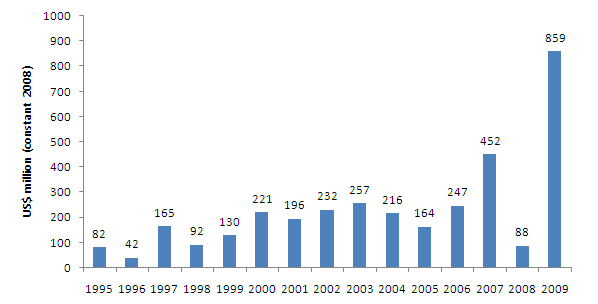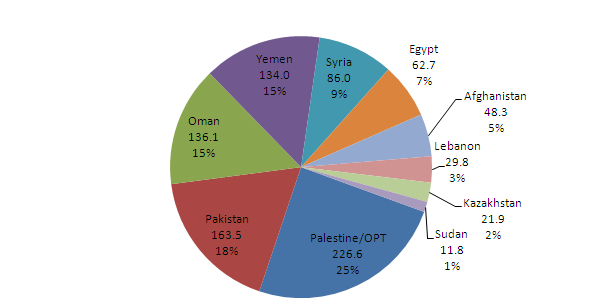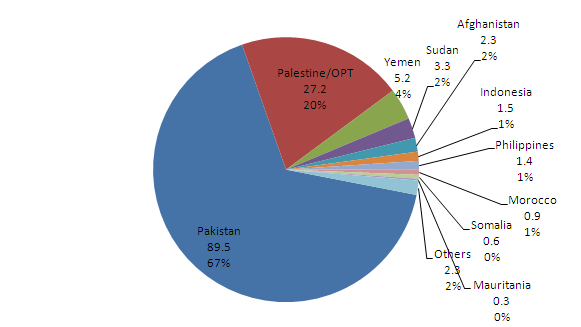The United Arab Emirates reports to the DAC: one step closer to better aid information?
This year’s Organisation for Economic Cooperation and Development (OECD) Development Assistance Committee (DAC) data release shows some interesting new aid information. The United Arab Emirates (UAE) has for the first time reported separately to the database whereas previously it reported collectively as ‘Arab donors’ along with Saudi Arabia and Kuwait.
The UAE’s reporting to the OECD DAC includes official development assistance (ODA) flows as far back as 1970 and bilateral humanitarian aid for 2009. In addition the UAE will be the first non-DAC donor to report to the DAC Creditor Reporting System (CRS) which will enable users to disaggregate the data by channel of delivery showing which agencies received its aid e.g. public sector, multilaterals, NGOs and civil society.
Trends in UAE’s ODA show peaks in 2007 and 2009, US$452 million and US$859 million respectively. Interestingly, aid significantly dropped in 2008 (US$88 million) which could be correlated to the global economic crisis and the plummeting of oil prices.

Figure 1: The United Arab Emirates’ official development assistance (ODA), excluding debt relief, 1995-2009, constant 2008 prices. OECD DAC data
The recipient allocation of UAE’s ODA shows regional priorities with the highest concentration of aid, 25% (US$226.6 million) going to Palestine/OPT, then Pakistan 18% (US$163.5 million), Oman 15% (US$136.1 million) and Yemen 15% (US$134.0 million). Seven of the top ten recipients are Arab states (excluding Kazakhstan, Afghanistan and Pakistan), which received 75% of the top ten recipient contributions, US$686.9 million.

Figure 2: Top ten recipients of the United Arab Emirates’ official development assistance (ODA), excluding debt relief 2009, constant 2008 prices. OECD DAC data
In 2009 the UAE reported US$138.9 million in bilateral humanitarian aid, ranking it the 15th largest government donor reporting to the DAC that year. The top five recipients of the UAE’s humanitarian aid in 2009 also appeared amongst the top ten recipients for ODA. In 2009 Pakistan received the highest proportion, 67% (US$89.5 million), followed by Palestine/OPT, 20% (US$27.2 million) and Yemen, 4% (US$5.2 million). The UAE’s humanitarian aid allocation again shows support to Arab states – six of the top ten recipients.

Figure 3: Top ten recipients of the United Arab Emirates’ humanitarian aid 2009, constant 2008 prices. OECD DAC data
The UAE has made significant efforts to make its aid more visible. In 2008 it established the Office for the Coordination of Foreign Aid (OCFA), an independent body to support the delivery and implementation of UAE’s development and humanitarian aid as well as retrospectively collect, analyse and report all aid flows from the UAE since 1971.
We welcome the UAE’s increased reporting of its aid information and hope in the future it will take further steps to make its aid data more transparent, timely and detailed.
To access the excel document click here
Related content
Priorities for the UK’s incoming Secretary of State Alok Sharma
As Alok Sharma takes office as Secretary of State, DI's Amy Dodd sets out key priorities for the UK and its global development agenda.
From review to delivery on the Global Goals – what should the immediate priorities be for the UK government?
On 26 June, the UK government published its Voluntary National Review measuring delivery against the Global Goals - but does it accurately capture progress?
Three priorities for the High-level Political Forum 2019
DI Director of Partnerships & Engagement Carolyn Culey sets out three key priorities for closing the gap between the poorest and the rest at HLPF 2019